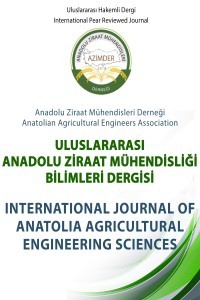
Uluslararası Anadolu Ziraat Mühendisliği Bilimleri Dergisi
Yazarlar: Zeynel DALKILIÇ
Konular:Bahçe Bitkileri
Anahtar Kelimeler:L-ascorbic acid,Human health,Subtropic and tropic climate fruit crops
Özet: Vitamins have a vital importance in human nutrition. From these, vitamin C deficiency causes scurvy disease. It was suggested to be consumed between at least 75 mg/person in females and 90 mg/person in males, and the most 2000 mg/person daily. The excess of it does not accumulate, but discarded. The natural form of vitamin C is L-ascorbic acid (hexuronic acid, C6H8O6, M.W.=176.12 g/L). It is a vitamin that water soluble, white, acidic, and sensitive to light. Humans cannot naturally synthesize ascorbic acid in their bodies. Therefore, ascorbic acid has to be taken daily by food sources. There is 70-83 mg in an orange and 88 mg in a grapefruit. Vitamin C has several health benefits as follows: increases body’s resistance against to microorganisms; strengthen blood veins; synthesizes 4-hydroxyproline amino acid required for making collagen in bones, joints, and veins; provides noradrenalin synthesis in the body; provides the synthesis of gall (bile) from cholesterol; is a strong antioxidant; provides the stabilization of vitamin E (tocopherol) and vitamin B9 (folic acid); provides carnitine synthesis, and contributes the transport of fatty acids. The highest amount of vitamin C containing subtropical and tropical fruit crops are relatively grouped in as follows (mg/100g): Group 1 (>600 mg/100g): acerola (Malpighia glabra) 4500, camu camu (Myrciaria dubia) 2280, kiwifruit (Actidinia chinensis) 1008; Group 2 (600-100 mg/100g): guava (Psidium guajava) 600, aonla (Phyllanthus emblica) 600, cashew apple (nut) (Anacardium occidentale) 372, persimmon (Diospyros kaki) 210, tamarind (Tamarindus indica) 202, black sapote (Diospyros nigra) 192, carambola (Averrhoa bilimbi) 183, pineapple (Ananas comosus) 165; Group 3 (100-50 mg/100g): feijoa (Acca sellowiana) 93, longan (Dimocarpus longan) 84, litchi (Litchi chinensis) 72, papaya (Carica papaya) 82, mango (Mangifera indica) 80, pomegranate (Punica granatum) 72, bael (Aegle marmelos) 60, orange (Citrus sinensis) 53, lemon (Citrus limon) 53, jamun (Syzygium cumini) 51, atemoya (Annona squamosa × A.cherimola) 50; Group 4 (<50 mg/100 g): rambutan (Nephelium lappaceum) 48, sugarapple (Annona squamosa) 42, banana (Musa spp.) 36, grapefruit (Citrus × paradisi) 33, plantain (Musa × paradisiaca) 31, white sapote (Casimiroa edulis) 30, passiflora (Passiflora edulis) 30, pitaya (Hylocerus undatus) 30, graviola (Annona muricata) 30, breadfruit (Artocarpus altilis) 29, mandarin (Citrus reticulata) 27, durian (Durio zibethinus) 24, avocado (Persea americana) 21, chempedak (Artocarpus polyphema) 20, woodapple (Feronia elephantum) 18, cherimoya (Annona cherimola) 16, sapodilla (Manilkara zapota) 15, fig (Ficus carica) 15, jackfruit (Artocarpus heterophyllus) 14, carob (Ceratonia siliqua) 8, coconut (Cocos nucifera) 3, mangosteen (Garcinia mangostana) 3, loquat (Eriobotrya japonica) 3, langsat (Lansium parasiticum) 1, olive (Olea europaea) <1.